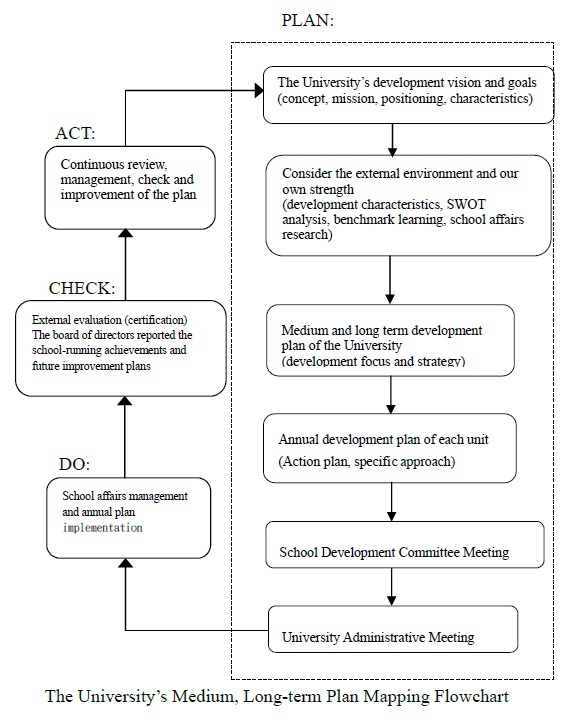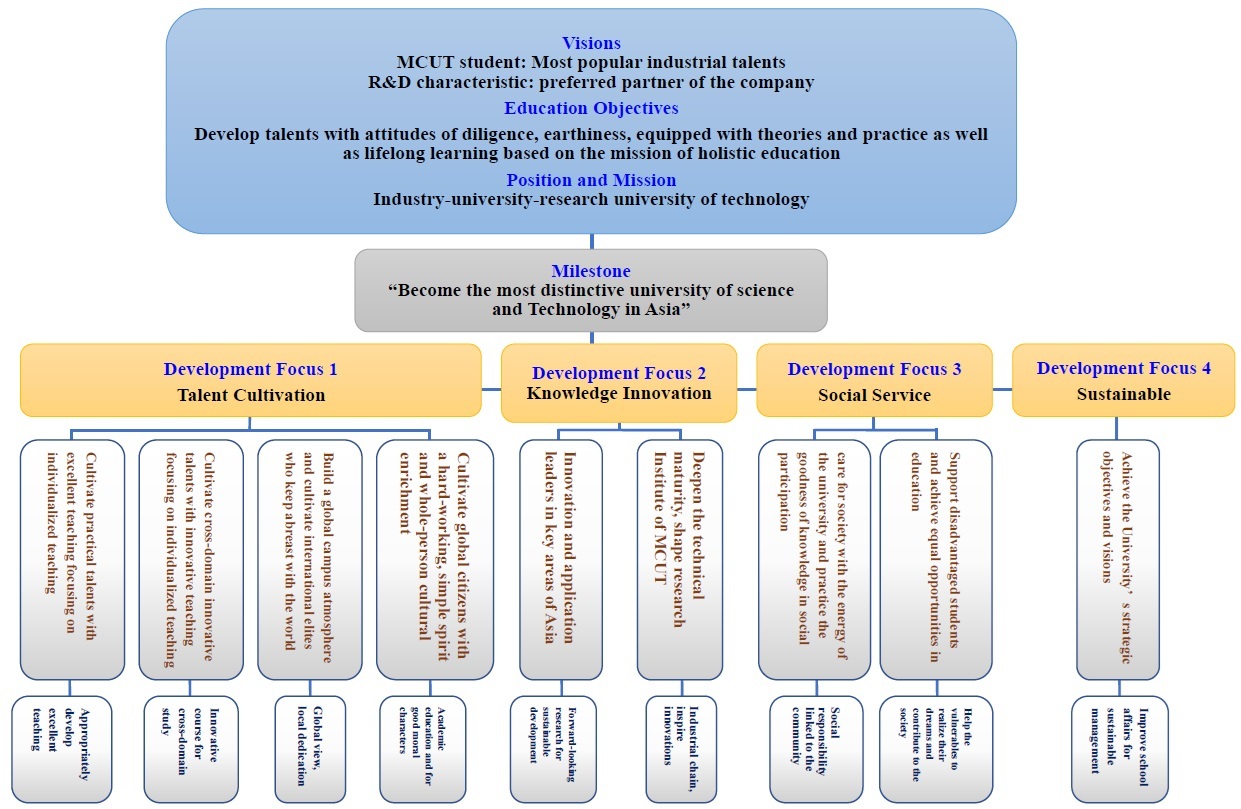Medium and long term plans
I. Medium, Long-term Plan Mapping Process
Based on the University’s development vision and goals, the University’s medium and long-term development plan is carefully formulated in accordance with the current subjective and objective environment, the future development trend of the country, and the three principles of practicality, continuity and creativeness. The plan is finalized after deliberation by the University Development Committee meeting and the University Council Meeting. In order to ensure the effectiveness of the implementation of the University’s affairs development plan, all units shall plan annual development plans according to the medium and long-term development plan, propose specific plans and action plans, and compile annual budgets, as well as follow the PDCA (Plan, Do, Check and Act) cycle for management to ensure the achievement of goals and continuous improvement mechanism (Figure 1).

II. SWOT Factor Analysis
(I) Strengths
- The school has a long history, with its philosophy widely recognized by the society.
- The school is financially sound, with long-term support and selfless dedication from the board of directors.
- Enjoy the abundant resources provided by Formosa Plastics and Chang Gung system to give full play to the advantages of combining theory and practice.
- With adequate full-time teacher, with low ratio of teacher and student, and close relationship between teachers and students.
- The number of teachers' journal papers, patents, technology transfer, and production and research projects is growing year by year.
- Excellent incentive system and benefits (flexible salary, research grant, research fund, teaching and research award, free dormitory, medical concession, pension increase).
- The teaching and research equipment is well-equipped, and the educational characteristics emphasize holistic education and social care.
- Actively set up cross-field research centers, effectively integrate resources, and establish industry-university cooperation models.
- Run as residential school to strengthen students’ teamwork and moral education.
- Provide honorary scholarships and bursaries, recruit outstanding talents, and combine the public funded student system to seamlessly connect talents.
- Provide a one-year industrial internship at home and abroad to help poor students complete their studies and expand their international horizons.
- With outstanding and cohesive alumni, provide students with scholarships, internships and employment opportunities.
- With large campus, beautiful environment, convenient transportation and more than 130 square meters of land for each student.
(II) Weaknesses
- The University is small, unfavorable for university ranking by running as a comprehensive university.
- There’s still a lack of professors and it’s difficult to hire master-level professors.
- The development of the college’s characteristics and research resource integration are to be improved.
- The cross-field industry-university cooperation and R&D team need to be strengthened.
- Innovation and development capabilities and internationalization need to be improved.
lCountermeasures
- The teachers rank high on an average, developing toward the characteristic fields of the University.
- Encourage and tutor the teachers for diverse promotion, build up excellent research environment and provide abundant resources and research manpower.
- Develop the characteristics of the college, focus on key areas, establish a cross-field characteristic research center, and develop into an industry-university-research university of technology.
- Make good use of the strength of Formosa Plastics and Chang Gung system as well as alumni to develop industry-university cooperation.
- Offer interdisciplinary courses to cultivate students’ problem-solving and innovation abilities, offer all-English courses, subsidize teachers and students to study abroad, and provide favorable conditions to recruit excellent foreign teachers and students.
(III) Opportunities
- The government’s push for a southward policy has helped expand the source of student.
- The Ministry of Education promoted the deep cultivation plan of higher education to re-shape the characteristics of technical and vocational education.
- Grants, research projects, commission projects and industry-university cooperation funds from the government and civic organizations.
- Adjacent to Xinzhuang MRT Danfeng Station, Airport MRT Taishan Guihe (Mingzhi University of Technology) station, greatly improving the transportation convenience.
- 16 hectares of newly purchased school land will be gradually put into use, which will help the school's sustainable development.
- New research building can help integrate R&D energy.
- Form a cross-domain team with Chang Gung to share resources and equipment.
(IV) Threats
- There are many public and private universities but with limited education resources, resulting in increasingly fierce competition.
- The outstanding research talents are more prone to be attracted by public universities, making it unfavorable for private universities’ development.
- Short of international faculty and research talents, making it hard to employ.
- The fewer child trend, coupled with enrollment of foreign schools in Taiwan have brought challenges to source of student.
- The industry outside-moving shrinks the employment market, salary and welfare of graduates.
lCountermeasures
- Develop more incentive measures to encourage teachers to seek external resources and enhance their competitiveness.
- Subsidize the establishment of interdisciplinary research centers to provide a stage for teachers' industry-academic research and development.
- Formulate a reward program for hiring and retaining excellent teachers, and actively recruit domestic senior professors or foreign excellent teachers.
- Develop school-running characteristics, enhance teaching quality, provide admission awards, bursaries and honors courses for various academic systems, strengthen digital marketing to attract poor, disadvantaged and outstanding students, introduce more advanced academic programs, and increase the proportion of postgraduate students year by year.
- In response to industrial development trends, plan the degree programs (such as industrial AI, semi-conductor programs, etc.), improve students’ employment competitiveness, raise the threshold of graduation by major, information certificate and English competency, thereby boosting graduates’ employment competitiveness.
III. Strategic Objectives and Development Focus
In response to the high level of competition in university education, the University actively seeks new changes to maintain its competitive edge, and regards the medium and long term development plan as the basic blueprint for the development of the University. Based on the University’s philosophy, positioning and mission, education objectives and development vision, and guided by SWOT analysis, benchmark learning and the big data research of the IR Center, the strategic objectives (milestones), four development focuses and nine strategies for the future development of the University have been developed taking into account the external environment and internal resources, as shown in Figure 2.

IV. Benchmark Study, Go for Excellence
For the development of the University, the formulation of the medium- and long term development plan is the consensus of the University’s positioning, development direction, school-running philosophy, education objectives and future vision, and its practice is the common responsibility and obligation of the University’s staff and students. Therefore, the medium and long-term development plan is not only the basis for the implementation of the University’s philosophy, strategic objectives, and action plans of the entire University, but its implementation effectiveness will also serve as a review and revision of the next stage of development; Therefore, how to practice the implementation, control and assessment of the medium- and long term development plan is an indispensable mechanism to achieve the strategic objectives. The key achievement indicators of this medium- and long term plan are summarized as follows:
(I) Development Focus 1: Talent Cultivation
- Continue to promote teaching innovation and IEET, ACCSB certification and 100% teaching quality.
- Wise, Virtuous, Diligent, and Plain, 100% of holistic education enrichment.
- Do While Learning in the workplace throughout the year to get 100% excellent industrial internship.
(II) Development Focus 2: Knowledge Innovation
- Build a quality environment and increase the per capita funding for faculty research and industry-academic project.
- Each teacher’s innovative production and research achievements (Double I*) in the past three years reach an average of more than 2 pieces per year.
- Dedicate to major industry through industrial practices and academic learning and create research center and mass production factories with enterprises.
- Actively establish cross-domain research center and become a leader in key areas in Asia.
(III) Development Focus 3: Social Service
- Know well about the environment and local education cultivation capacity.
- MCUT Art Gallery and local participation.
- Improve publicity of advanced education to fulfill social responsibility.
- Improve the rate of academic progress of economically and culturally disadvantaged students.
(IV) Development Focus 4: Sustainable Development
- Participate in THE World University Evaluation to improve the international ranking.
- Promote net zero carbon emission for a sustainable development.
- Promote the analysis of school research issues.
- Enhance the competitiveness of students in the workplace and increase the employment rate of graduates.
For the long-term objectives (6-10 years) concerning talent cultivation, in response to the University’s needs to cultivate future talent for “MCUT Industry-University-Academic Institute”, the long-term objectives have been set to be offering Ph.D. programs with international characteristics, international elite programs and cross-domain degree programs in all research centers to keep abreast with the international forward-looking colleges. For the long-term objectives concerning knowledge innovation, MCUT Innovative, Scientific, and Technological Park will focus on the trends of future industrial development by founding forwarding-looking research center by joint efforts of the industry and University through the aspects of design, R&D, construction testing and pilot mass production, in an aim to commercialize the products developed by the University and gradually achieve the objective of being a “industry-university-research university of technology” set by the University. Finally, in order to achieve the University’s objective of sustainable management, the University is expected to complete a new building with a total area of 119,005.2 square meters, including the Research Building in 2025, Engineering Building in 2029, Administration Building and Student Dormitory in 2033, demonstrating its commitment to sustainable development.









